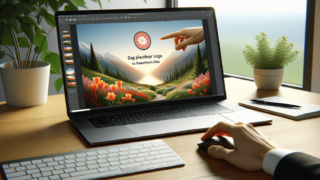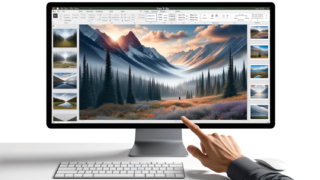
How to Make a Picture a Background in PowerPoint?
Written by: Bill Whitman
Last updated:

How to Make a Picture a Background in PowerPoint
Setting a picture as a background in PowerPoint slides can enhance the visual appeal of your presentation. Here’s a straightforward guide to do it: Go to the slide where you want to add a background picture. Click on the ‘Design’ tab, then select ‘Format Background’. Choose ‘Picture or texture fill’ and click on ‘File’ to insert a picture from your computer. Adjust the transparency slider if needed and click ‘Apply to All’ for consistency across all slides.
Quick Summary
- Navigate to the ‘Design’ tab and select ‘Format Background’.
- Choose ‘Picture or texture fill’ and then ‘File’ to insert a picture from your device.
- Adjust transparency as needed.
- Click ‘Apply to All’ to set the picture as the background for all slides.
At LearnPowerpoint.io, we’re dedicated to providing you with trusted advice to enhance your PowerPoint presentations. In this blog post, we’ll dive deeper into how you can make a picture the background of your slides to create more engaging and visually appealing presentations.
Selecting the Right Picture
Before setting a picture as your background, make sure it’s of high quality and relevance to your presentation. A background image should complement your content, not distract from it. Opt for images with moderate textures or gradients that don’t overpower the text or graphics you intend to overlay.
Adjusting the Picture Background
Once you’ve chosen your picture, PowerPoint offers tools to adjust its appearance. The ‘Format Background’ pane allows you to modify the transparency of your image. This is particularly useful if you need to make text or other elements more visible against the background picture. Playing with the transparency slider can help you achieve the right balance.
Applying the Background Consistently
Consistency across all slides is key to a professional-looking presentation. After setting your picture as the background for the first slide, remember to click on ‘Apply to All’ in the ‘Format Background’ pane. This ensures that all your slides will have the same look and feel, providing a cohesive visual experience for your audience.
Alternatives to the ‘Apply to All’ Feature
If you prefer not to use the same background for every slide, PowerPoint allows you to customize the background of individual slides. Simply follow the initial steps to insert a background picture, but instead of clicking ‘Apply to All’, just close the ‘Format Background’ pane. Then, move to another slide and repeat the process with a different picture if desired.
Remember that at LearnPowerpoint.io, we emphasize the importance of not just knowing how to perform a task, but understanding the best practices that make your presentations stand out. Choosing the right images, ensuring they enhance your message, and applying them consistently can significantly impact the effectiveness of your PowerPoint presentation.
Conclusion
Making a picture a background in PowerPoint slides is a simple yet powerful way to elevate your presentation’s visual appeal. By selecting appropriate images, adjusting their settings for optimal text visibility, and applying them across your slides, you can enhance your audience’s engagement and convey your message more effectively. Remember to use these tools thoughtfully to support, not detract from, the content of your presentation.
Featured Posts
- No pillar pages found.








